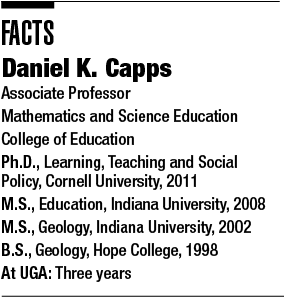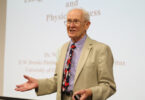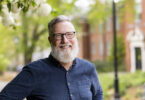 With an overwhelming amount of information to learn, process and teach, science educators are faced with the challenge of creating engaging learning experiences for students who often struggle to learn complex scientific concepts.
With an overwhelming amount of information to learn, process and teach, science educators are faced with the challenge of creating engaging learning experiences for students who often struggle to learn complex scientific concepts.
This is where associate professor Daniel Capps hopes to make a difference.
“It’s hard for students to learn challenging science concepts, like cellular respiration. There’s so much information that sometimes it’s hard for teachers to know what is important to teach,” said Capps, who works in the mathematics and science education department. “A central focus of my research is figuring out how to develop successful learning environments by structuring science learning with the support of modeling.”
With a background in geology, learning and teaching, Capps conducts studies on how students and teachers learn science. Recently, his interest in teacher instruction has evolved to include model-based inquiry, which can be used to teach challenging science concepts.
As the principal investigator of a $449,849 grant from the National Science Foundation, Capps and co-principal investigator Jonathan Shemwell at the University of Alabama are working with several schools to advance students’ understanding of science concepts using models, while also enhancing the instruction of science educators.
“The three-year project will directly impact at least 1,000 students from Georgia and Alabama, including a high proportion of students from underrepresented populations,” said Capps.
At the end of the day, creating an effective learning environment often starts with effective instruction.
“There are lots of ways that complex science topics can be taught, but we are looking for instructional methods that help structure learning in a way that students can actively make sense of new information instead of becoming overwhelmed by it,” he said. “We think that modeling can help provide this structure.”
This past summer, Capps and his colleagues conducted their first modeling institute with dozens of high school biology teachers. Together, they created models that simulate the energy processes of cellular respiration to use in their own classrooms this fall.
During this time, Capps will support these teachers while studying the effects of modeling activities on student learning. After splitting each class into a modeling and control group, his team will conduct classroom observations and analyze pre- and post-tests of student knowledge to assess their understanding of models and the impact these constructions have on students’ science knowledge.
Through modeling, Capps and his team are not only helping biology teachers implement new techniques in the classroom, but they also are building a close community of educators who can exchange ideas, receive professional development and ultimately become leaders of an innovative approach to modeling in science education.
He is also working closely with several graduate students during this three-year study. Under his mentorship, they will gain firsthand experience collecting and analyzing data and preparing research manuscripts for conferences and journal publications. In fact, many of his students plan to use their knowledge on the job to conduct their own studies in the future.
“Research is really hard,” said Capps. “And I’m eager and excited to involve graduate students in the learning process as both a mentor and a researcher.”
Since joining the College of Education in 2015, Capps has taught several methods courses in education and a course on how to use technology in science classrooms. As many graduates of the education college go on to work in area schools, Capps has maintained close connections with alumni who are eager to continue working with him on developing innovative approaches to teaching science.
“Our work helps fill a vacancy by putting forth an approach to modeling that supports students in learning,” said Capps.







